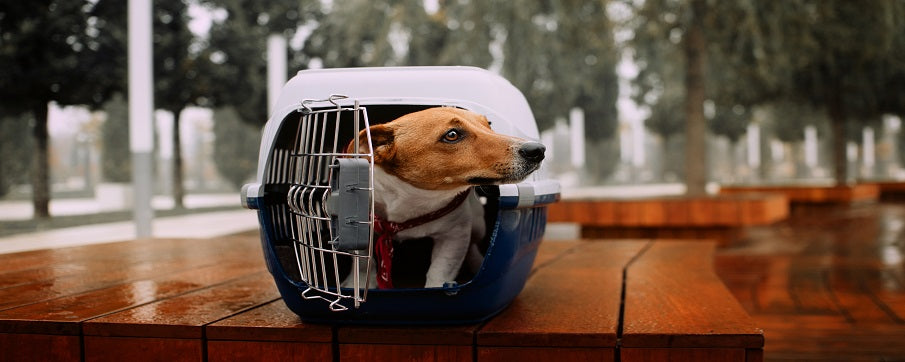
When to Stop Using a Puppy Crate for Your Dog
Share
All puppies and dogs are different. They have different personalities and mature at different rates. Consequently, there is no right time to stop using a puppy crate. However, several factors are involved in this transition, affecting your decision's timing. People generally use a crate to help with toilet training and reduce destructive behaviour from tiny teeth. You could stop using a puppy crate once you have toilet-trained your puppy and are confident that he will not chew when left alone. However, you may find that your dog enjoys his crate and regards it as his safe place to retreat to at the end of the day or when he feels overwhelmed by family life. Crates aren't just for puppies; they can be an incredibly useful tool to have on hand throughout your dog's life. If you keep using a crate for your adult dog, ensure it is large enough for him, as you may have used a suitable size for a puppy.
How Long Should You Crate Train Your Puppy?
Crate training is a valuable part of training and can prove very helpful when toilet training your puppy. Crates can also be helpful to prevent destructive behaviour in young dogs. However, as these behaviours reduce, you can change how you use your crate. It can be useful to continue using your crate, as there are certain situations where being able to crate your dogs is useful. If you are travelling, if your dog has an injury, or if you have visitors who dislike dogs or have young children. If you continue to use the crate into your puppy's adulthood, you will always have the option to crate him if needed. Many people simply leave the crate in their house but no longer shut the door, and often, dogs will choose to sleep in their crates.
When to Stop Crating Your Young Dogs
Once your puppy is house-trained and has grown out of the destructive phase, you can stop crating him. However, a crate can still be a useful resource for an adult dog. Many dogs like their crates, and by taking them away, you could be depriving him of somewhere that he felt safe and secure. You can leave the crate in your home but no longer shut the door. This has the advantage that if bad behaviour arises, it will be easy to reinstate your crating routine without retraining your dog to use a crate.
Signs that Your Puppy is Ready to Stop Using a Crate
Once your puppy has stopped having accidents in the house and can tell you when he needs to go outside to the toilet, you can be confident that you can stop the crate train routine from a toileting point of view. Learning to be settled and non-destructive when left alone can be more challenging. If you feel your puppy is happy when left, you could start leaving him for short periods without closing the door on his crate. Take the normal sensible precautions, such as making sure he has been walked before being crated, that he has plenty of toys to play with, and that you gradually increase the crate time that he is left alone.
Things to Consider
As with all training, the main thing to remember is that every puppy is different. Even puppies out of the same litter, being trained together, will progress at different rates. Don't set your timescales in stone and be flexible with the crate-free-time. Don't think, “I want that training crate out of my sitting room in 6 months”, or else you will create unnecessary pressure and probably end up with the training taking longer. Remember that puppies can regress. Therefore, leaving the crate available makes it easy to reinstate your crate training if your puppy suddenly becomes destructive again.
How to Transition Your Pup Out of the Crate?
If you plan on transitioning your puppy out of his crate, you need something to transition him into. You may have given him a bed, a place on your sofa, or a larger indoor crate. Start by setting up the new safe place before removing the crate so that he learns this is his new space. Repeat the training you did when you introduced him to the crate, make his new space inviting, tempt him with treats, and don't pressure him into using it. This transition may be very simple. Lots of dogs would rather sleep on the sofa than anywhere else! Or it could be challenging, as your dog may be very attached to his crate. Some dogs enjoy the cave effect of a crate and like to be tucked away in a covered area. You should work out what your dog likes to give him a place to feel happy.
Alternatives to Crating
While crate training is increasingly popular, there are other options as a training tool. Many people use alternatives to train their dogs and to keep them safe. Playpens are a popular option, giving your dogs room to bounce around without damaging anything. Baby gates to restrict access to certain areas of the house are also a common solution. Or some people simply create a dog-proof room where they know their dog is safe. If you don't feel crating is the best option for you or your dog, there are other ways to help you train your dog and keep him safe.
How To Choose the Best Dog Crate
We have many crates at Dog Kennels Direct designed to suit different dogs. We have a dog crate, whether you have a tiny Yorkshire Terrier or a large Great Dane. Our crates are sturdy, robust and well-made, with easy-to-open doors and a removable plastic pallet for easy cleaning and comfort. Take a look at our range of dog crates, or if you want advice on the best size of crate for your dog, then call us on 01942 316 431



